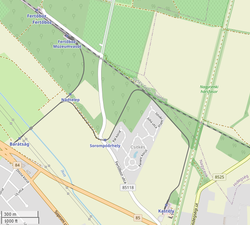Széchenyi Museum Railway
| Széchenyi Museum Railway | |
|---|---|
|
"András" steam locomotive
| |
|
Route
| |
| Route length: | 3.6 km |
| Gauge : | 760 mm ( Bosnian gauge ) |
The Széchenyi Museum Railway is a museum railway in western Hungary that connects Fertőboz (connection to the Sopron - Győr railway line ) with the Széchenyi Castle in Nagycenk . The narrow-gauge railway with a track width of 760 mm has a total route length of 3.6 km. In contrast to most of the museum railways, the route has no historical model. It was partly built on the normal-gauge route of the abandoned connecting railway to the former Nagycenk sugar factory and partly completely new. The route of the museum railway was put into operation in 1972 as a pioneer railway , that is, the operation with passengers (as well as on the Budapest children's railway ) was led by children with adults as locomotive drivers. Today the Széchenyi Museum Railway is looked after by the GySEV / Raaberbahn , children and young people still do voluntary work in their free time.
The main seat of the Hungarian noble family Széchenyi is located in Nagycenk . One member of this family was Count István Széchenyi , who was, among other things, the first Hungarian transport minister. This railway was named after him. The museum railway currently has one quadruple coupled and two triple coupled steam locomotives , as well as eight passenger and two baggage cars . In Nagycenk, one of the end points of the line (Kastély station), an open-air museum has been built, where numerous non-operational steam locomotives, including those of other gauges, are exhibited.
Web links
- Széchenyi Museum Railway on the GySEV website
- Description from Tourinform Sopron (German)
- Michael Schneider: On the trail of a Hungarian museum train. In: Der Modelleisenbahner , 7/81. S 198-199.
- Description from the Association of Railway Friends (German)
Coordinates: 47 ° 37 ′ 28 " N , 16 ° 42 ′ 44" E


